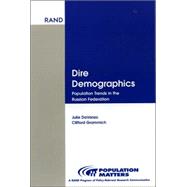| Preface | p. iii |
| Figures | p. vii |
| Tables | p. ix |
| Summary | p. xi |
| Acknowledgments | p. xvii |
| Russian Demography And Its Implications | p. 1 |
| Russian Demographic Trends in the 1990s | p. 1 |
| Policy Issues Arising from Demographic Trends | p. 5 |
| Population Change In Russia | p. 9 |
| Population Loss in the 1990s | p. 9 |
| Immigration | p. 13 |
| Fertility In Russia | p. 21 |
| Trends in Fertility | p. 21 |
| Abortion and Contraception | p. 25 |
| History of Abortion and Contraception in Russia | p. 28 |
| Recent Declines in Abortion | p. 31 |
| The Role of Contraception in Reducing Abortion | p. 32 |
| Reaction Against Contraception and Abortion | p. 35 |
| Prospects for Future Fertility and Population Growth | p. 36 |
| Causes And Implications Of Russian Mortality | p. 37 |
| Russian Population Losses and Declining Life Expectancy | p. 37 |
| Increasing Mortality for Working-Age Males | p. 40 |
| Changing Causes of Working-Age Male Mortality | p. 43 |
| Health Care in Russia | p. 48 |
| Resurgence of Russian Tuberculosis | p. 51 |
| The Growth of HIV/AIDS in Russia | p. 55 |
| Conclusion | p. 56 |
| Explanations for Recent Trends in Russian Working-Age Mortality | p. 57 |
| Environment | p. 57 |
| Alcohol | p. 58 |
| Social and Economic Change | p. 61 |
| Demographic History, Age Structure, And Future Policy Issues | p. 63 |
| Age and Sex Structure of the Russian Population | p. 63 |
| Policy Implications of the Current Population Age Structure | p. 66 |
| Elderly Population | p. 66 |
| Working-Age Population | p. 68 |
| Military-Age Population | p. 69 |
| Youth Population | p. 71 |
| Dependency Ratios | p. 71 |
| What Can Be Done To Address Demographic Policy Issues In Russia? | p. 75 |
| Health Care Education | p. 75 |
| Health Care System and Financing | p. 77 |
| Other Government Health Initiatives | p. 79 |
| Long-Term Issues | p. 81 |
| Bibliography | p. 85 |
| Table of Contents provided by Syndetics. All Rights Reserved. |









